In child development, it is essential to help your child improve hand-eye coordination through fun, engaging activities. Activities like popping bubbles, playing reaching games, and building with blocks are entertaining and vital for boosting your child’s motor skills and cognitive development. Making these activities a regular part of your child’s playtime gives them the tools to grow and succeed.
You might wonder how these simple games can have such a significant impact on your child’s development. The truth is that these activities are essential for refining hand-eye coordination, which plays a crucial role in many aspects of daily life and learning. As your child’s hand-eye coordination improves, so does their ability to interact with the world around them, helping them build confidence and achieve milestones with greater ease.
Key Takeaways
- The “Bubbling Fun: Popping Bubbles” activity encourages kids to refine their hand movements and improve coordination through play.
- “Getting Artsy: Copycat Drawing” enhances kids’ hand-eye coordination, creativity, and focus with precision-based drawing tasks.
- Splish Splash: Water Play Activities” offer opportunities to foster exploration and fine motor skills, enhancing hand-eye coordination in a fun environment.
- “Reach for It: Targeted Reaching” helps kids understand their surroundings and encourages improved skills through targeted hand-eye coordination exercises.
Understanding Hand-Eye Coordination
Hand-eye coordination, often considered the unseen bridge linking vision and action, is an essential skill that children gradually develop to perform everyday tasks such as writing, catching a ball, or threading a needle. It is crucial to early childhood growth and contributes significantly to a child’s motor skills and cognitive development.
This pivotal skill allows children to coordinate their visual input with their hand movements, enabling them to interact effectively with their surroundings. Hand-eye coordination is crucial in a child’s daily activities, from grasping objects to drawing shapes. As they age, these coordination skills become even more critical in tasks requiring precision and accuracy, such as threading a needle or playing an instrument.
Monitoring a child’s development of hand-eye coordination provides valuable insights into their physical and cognitive progression. Celebrating milestones, identifying areas for improvement, and giving appropriate activities can enhance their coordination skills. Engaging in activities that strengthen hand-eye coordination improves focus, concentration, and problem-solving skills and fosters bonding between children and caregivers, encouraging exploration, discovery, and a sense of achievement.
Importance of Coordination Activities
Engaging in coordination activities is a powerful tool to nurture children’s fine motor skills and hand-eye coordination, paving the way for enhanced visual tracking, spatial awareness, and cognitive abilities. Children can significantly improve their visual perception and interpretation by immersing themselves in activities and games that challenge their agility and responsiveness. This allows them to understand and interact with their surroundings more effectively, fostering their overall development.
Regular practice of coordination activities leads not only to better physical growth but also to cognitive development. These exercises promote concentration, problem-solving, and creativity, thus equipping children with essential skills needed for academic and life success. It’s not just about honing fine motor skills or hand-eye coordination; it’s about instilling confidence and self-esteem in children by enabling them to master tasks independently.
In essence, coordination activities lay the groundwork for a child’s physical, cognitive, and feeling well-being. Through these exercises, kids gain control over their bodies and environment, leading to healthier and more balanced growth. Consequently, incorporating hand-eye coordination activities into a child’s routine is an investment in their future, contributing significantly to their overall development and well-being.
Observing Child’s Progress
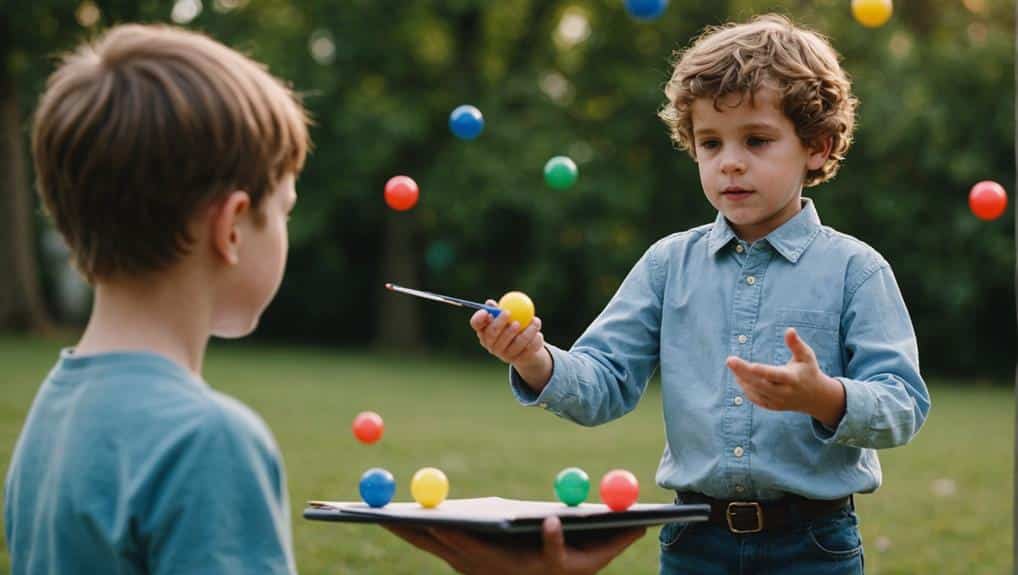
Observing a child’s progress in hand-eye coordination is essential for their growth and development. This includes tracking improvements, celebrating milestones, and identifying areas that need further enhancement. By doing this, caregivers can provide targeted support, promote continued development, and instill a sense of accomplishment in the child.
Tracking Improvements
To achieve the best results from these hand-eye coordination exercises, it is essential to consistently monitor your child’s progress, celebrate milestones, and pinpoint areas that need further development. Tracking improvements in hand-eye coordination can be a powerful tool in tailoring Activities to Improve this essential skill.
Here are four simple steps to better track your child’s progress:
- Consistent Observation: Regular observation of your child engaged in hand-eye coordination activities allows you to identify their strengths and areas for improvement. This helps tailor exercises that suit their current abilities and desired skill levels.
- Record Keeping: Maintain a log of your child’s performance in different exercises. This will give you a clear picture of their growth over time and help identify any patterns or trends in their development.
- Adjusting Activities: Based on your observations and records, you can adjust the exercises to challenge your child and enhance hand-eye coordination.
- Celebrating Progress: Even minor improvements are significant. Celebrating these boost your child’s confidence and motivates them to continue practicing.
Celebrating Milestones
With meticulous monitoring of your child’s accomplishments in hand-eye coordination activities, acknowledging and celebrating these milestones can significantly enhance their self-esteem and foster a positive attitude toward learning. Each small step forward indicates marked improvements and achievements that need recognition. This boosts their morale and infuses them with accomplishment and pride.
The journey of progress is as significant as the destination itself. When your child successfully threads beads, catches balls, or neatly cuts pieces of paper, they have achieved milestones. These victories deserve to be celebrated. Encourage, applaud, and let them know you are proud of their strides.
In addition, observing your child’s progress in hand-eye coordination activities provides you with valuable insights. You can identify their strengths, understand their struggles, and adjust activities based on their abilities. This targeted support and encouragement promote continued development, fostering a love for learning and growth.
Identifying Development Areas
When enhancing hand-eye coordination in children, carefully tracking their progress is essential in identifying areas for further development. As parents, caregivers, or educators, we facilitate growth in children’s fine motor and visual perception activities, contributing significantly to their overall development.
- Monitoring Progress: Regularly observe your child’s ability to perform tasks that require hand-eye coordination. This could include catching and throwing or more detailed activities like drawing or using utensils. Note improvements as well as areas where they struggle.
- Celebrating Milestones: Every successful catch, improved drawing precision, or other milestones should be celebrated. These achievements encourage children to keep practicing and refining their skills.
- Identifying Development Areas: Pay special attention to tasks your child finds challenging. These are potential areas where more practice or different approaches might be needed.
- Adjusting Activities: Gradually increase the difficulty of activities based on your child’s abilities. This will push their limits, promote growth, and challenge their hand-eye coordination skills.
Contribution to Overall Growth
Hand-eye coordination activities catalyze children’s overall growth, enhancing their physical, cognitive, and social development. The importance of hand-eye coordination cannot be overstated. By engaging children in activities to improve motor skills and hand-eye coordination, we foster their exploration and discovery and cultivate a sense of achievement.
These activities fuel physical and cognitive growth. They provide opportunities for observation, feedback, and resilience development, aiding the child’s holistic growth. Tracking improvements and celebrating milestones further boosts the child’s confidence and self-esteem.
But, the benefits of eye-hand coordination exercises extend beyond the tangible domain. They also contribute to social development by promoting bonding between children and caregivers. Adjusting activities based on the child’s abilities enhances the experience, making it more personalized and beneficial.
| Area of Development | Contribution of Hand-Eye Coordination Activities |
|---|---|
| Physical Growth | Enhances motor skills |
| Cognitive Growth | Encourages observation and resilience |
| Social Growth | Promotes bonding and cooperation |
| Emotional Growth | Boosts confidence and self-esteem |
| Overall Growth | Fosters a positive attitude towards learning |
These contributions underscore the need for incorporating hand-eye coordination activities in children’s regular routines.
Bubbling Fun: Popping Bubbles
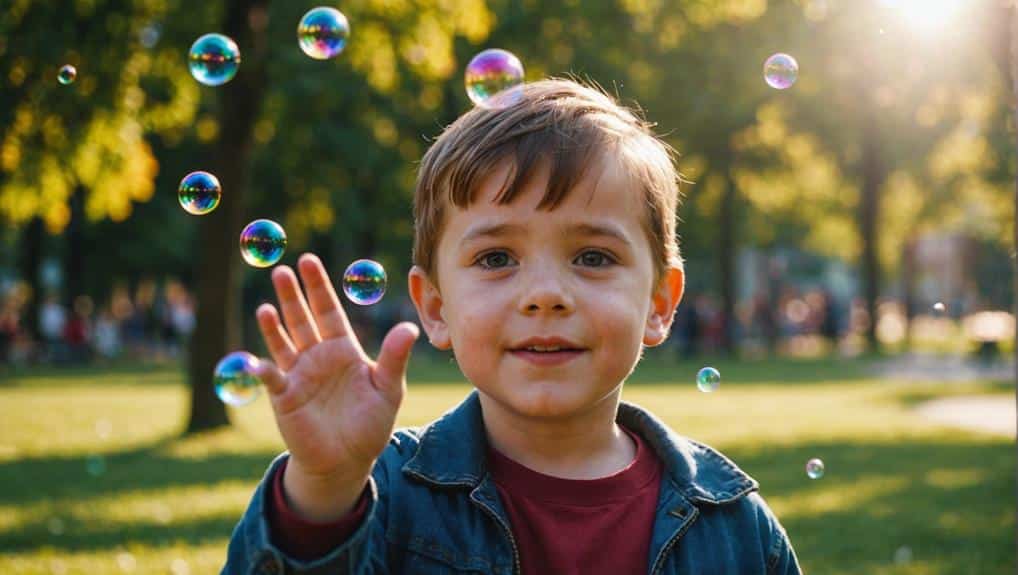
In exploring hand-eye coordination exercises, we now turn to the joyous and beneficial activity of popping bubbles. This playful pastime provides an enjoyable sensory experience, boosts visual tracking skills, and refines hand movements. As children chase and pop these floating spheres, they unknowingly enhance their coordination and reflexes, making bubble popping an exciting and productive exercise.
Enhancing Coordination Skills
With a burst of color and delightful fun, popping bubbles is an invaluable exercise to enhance hand-eye coordination in children. This engaging activity, often seen as merely an enjoyable pastime, significantly benefits a child’s motor skills development.
The process includes several stages that collectively aid in honing their hand-eye coordination:
- Visual Tracking: This is the first step, where children watch the bubbles float and move, training their eyes to follow a moving target.
- Aiming: Children attempt to reach the bubble, aiding hand-eye coordination.
- Popping is the most fun part, where children’s fine motor skills come into play as they coordinate their hand movements to pop the bubble.
- Focus and Concentration: Promoting focus requires a certain concentration level.
These activities provide a playful way for a child to develop coordination skills while having fun. Hence, the simple act of popping bubbles turns into an all-encompassing exercise that fosters growth in various aspects of a child’s physical development, especially hand-eye coordination, which is crucial for many life skills.
Bubbles Popping Process
An abundance of joy and learning awaits children in the seemingly simple activity of bursting bubbles, a potent tool for enhancing hand-eye coordination. Tracking and popping bubbles in flight requires precise hand movements and keen visual monitoring skills, making it an excellent exercise for young learners.
Children can practice this exciting activity using bubble wands or bare hands. The goal is to reach and burst the bubbles, which calls for a quick action-reaction play. It’s a fun, engaging way to boost their reflexes and coordination abilities, helping them with overall physical and cognitive development.
Moreover, bubble-bursting can be enjoyed indoors and outdoors, providing a versatile and playful way to improve children’s hand-eye coordination. The bubbles’ erratic movements make this activity more challenging and stimulating for the kids, enhancing their anticipation and decision-making skills.
Getting Artsy: Copycat Drawing
Let’s explore an artistic approach to enhancing hand-eye coordination in children called ‘copycat drawing.’ This activity improves hand-eye coordination and strengthens fine motor and visual processing abilities.
Copycat drawing is a structured yet creative exercise where children replicate various shapes, patterns, or images. It demands attention to detail, precision in hand movements, and patience, all contributing to developing essential skills. Here are four key benefits of this activity:
- Enhances Hand-Eye Coordination: As kids draw the shapes or patterns they see, the brain and the hands work together, improving hand-eye coordination.
- Strengthens Fine Motor Skills: This activity requires precise hand and finger movements, thereby honing fine motor skills.
- Boosts Visual Processing: Copycat drawing challenges children to correctly interpret and reproduce what they see, enhancing their visual processing abilities.
- Promotes Creativity and Focus: While children work to replicate the drawings accurately, they can also get creative and add their unique touch, thereby fostering creativity and focus.
Splish Splash: Water Play Activities
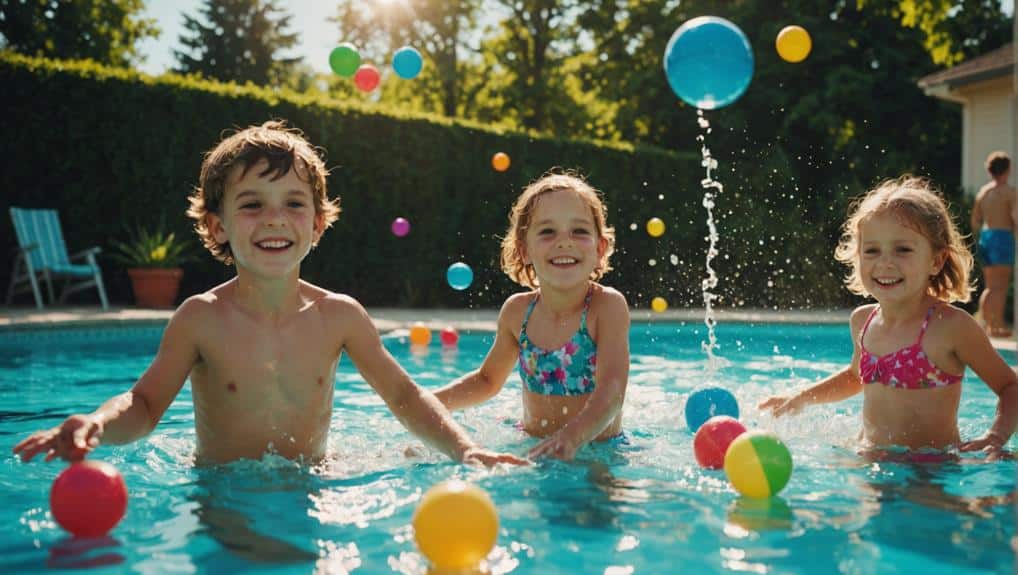
While indoor drawing activities have benefits, stepping outdoors for some water play can offer a fun and tactile approach to enhancing hand-eye coordination in children. Water play activities, such as scooping, pouring, and splashing, present exceptional opportunities for children to refine their motor skills in an engaging and interactive environment. Children practice precise hand movements and develop visual processing abilities by filling and emptying containers and playing with water toys.
Beyond the joy it provides, water play is a sensory-rich experience that fosters exploration and creativity. It allows children to experiment with different movements and reactions, strengthening their fine motor skills and hand-eye coordination. As children navigate the water, they intuitively learn about the cause-and-effect relationship, enhancing their understanding of the world around them.
Reach for It: Targeted Reaching
How about boosting your child’s hand-eye coordination with targeted reaching exercises? These activities are not only fun but also play an essential role in developing crucial skills in children. Targeted reaching helps enhance spatial and depth perception, making children more aware of their surroundings.
- Choose the Target: Use stickers, toys, or markers as targets. Choosing bright, colorful objects can make the activity more engaging.
- Set the Distance: Start by placing the targets close to the child and gradually increase the distance as their skills improve. This progressive challenge enhances depth perception.
- Reach for It: Encourage your child to reach for the targets. This is where hand-eye coordination comes into play. The child’s eyes must accurately guide their hand movements to reach the target.
- Consistent Practice: Regular practice is crucial in improving targeted reaching skills. Make it a daily or weekly activity to help your child develop better hand-eye coordination.
Targeted reaching exercises are essential to improve your child’s hand-eye coordination. They are simple, enjoyable, and beneficial, providing a solid foundation for your child’s developmental journey. Remember, the goal is to reach the target and enjoy the process!
Bean Bag Toss Games
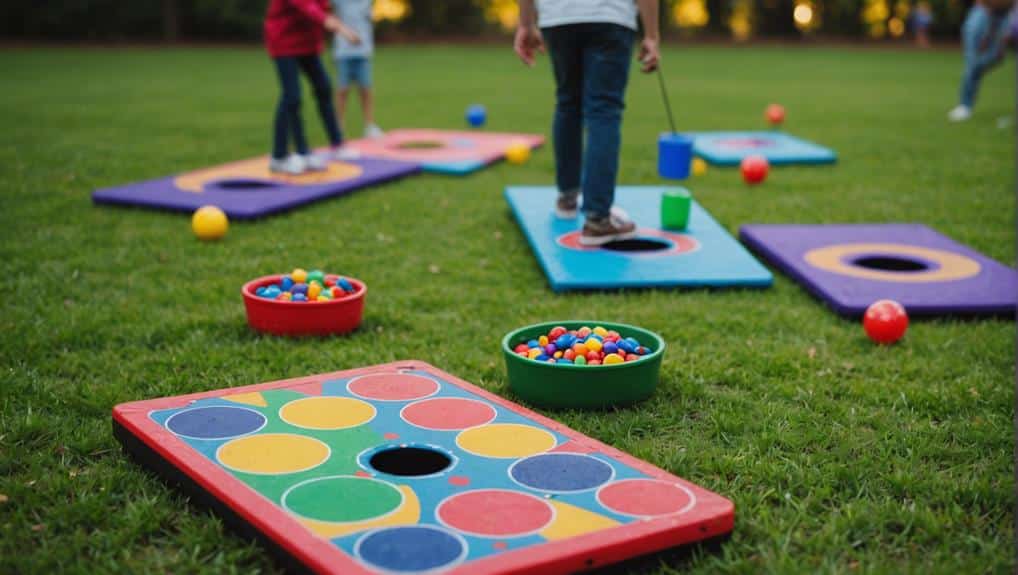
Bean bag toss games are an effective and enjoyable method for children to bolster hand-eye coordination. We will explore various tossing techniques suitable for kids and engaging bean bag games. Moreover, we will discuss how these activities can enhance a child’s coordination, precision, and motor skills.
Tossing Techniques for Kids
Incorporating bean bag toss games into a child’s playtime can significantly enhance their hand-eye coordination, as these activities require precise aiming and throwing techniques. This fun method of playing develops motor skills and serves as an excellent platform for children to refine their tossing techniques.
- Aim: Fostering good aim is pivotal in bean bag toss games. Practice makes perfect; consistent aiming at targets can improve a child’s depth perception and spatial awareness.
- Toss: Throwing or tossing the bean bag requires the child to use hand-eye coordination. This action is a motor skill that becomes more accurate with repetition and time.
- Concentration: Bean bag toss games require focus. The child must concentrate on their aim, the strength of their toss, and the trajectory of the bean bag. This helps develop their ability to concentrate and focus.
- Repetition: Repeating aiming and throwing helps solidify these motor skills over time. Regular play allows the child to refine coordination and precision continually.
Fun Bean Bag Games
Opening up the world of fun and development, bean bag games offer a delightful platform for children to enhance their hand-eye coordination and motor skills while having a great time. These games and activities are an efficient way to foster essential skills in children, promoting accuracy and precision in their movements.
For instance, a series of bean bag tosses into targets like baskets or hula hoops can significantly boost children’s aiming skills. These games also encourage children to focus, enhancing their concentration abilities. As they throw the bean bag, attempting to hit the target, they unknowingly work on their hand-eye coordination and motor skills.
Moreover, bean bag gamaren’tn’t limited to outdoor play. They are equally effective as indoor games. A game involving a bean bag, much like catching a ball, can be a source of fun and learning in the comfort of their homes.
With their engaging nature, these games serve as entertainment and contribute significantly to children’s physical and cognitive development. The joy of playing and the thrill of learning coexist in these delightful bean bag games.
Enhancing Coordination With Tossing
Exploring the world of tossing games, especially those involving bean bags, offers a dynamic and entertaining approach for children to hone their hand-eye coordination skills. Bean bag toss games are enjoyable and excellent for developing gross and fine motor skills.
- Throwing and Catching: Tossing a bean bag requires control and precision, facilitating the development of gross motor skills. Catching the bean bag, on the other hand, refines fine motor skills and enhances hand-eye coordination.
- Aiming: Throwing the bean bag at a specific target improves aiming skills and precision. It also enhances visual tracking abilities while promoting concentration and focus.
- Motor Coordination: Throwing and catching bean bags simultaneously engages and improves both gross and fine motor skills, fostering overall motor coordination.
- Repetition: Regular practice of these activities provides a playful and engaging way for kids to steadily improve their hand-eye coordination abilities.
Incorporating bean bag toss games into children’s routines can significantly enhance their coordination and offer a solid foundation for overall motor development.
Engaging in drawing Activities
How can we enhance children’s and children’s eye coordination while fostering their creative abilities? One effective method is to engage them in drawing activities. These activities require precise movements to create shapes and patterns, improving hand-eye coordination. Additionally, they aid in developing fine motor skills, essential for writing and detailed tasks.
Using various utensils such as pencils, markers, and crayons during these activities diversifies the child’s experience and enhances hand-eye coordination. More importantly, drawing allows children to practice visual-motor integration, leading to better eye and hand coordination. Beyond its benefits for coordination, drawing activities foster imagination and artistic skills, contributing to a well-rounded development.
Below is a simple table summarizing the benefits of drawing activities:
| Benefit | Explanation | Utensil Used |
|---|---|---|
| Fine Motor Skills | Develops control for detailed tasks | Pencils, markers, crayons |
| Visual-Motor Integration | Improves coordination between eyes and hands | Pencils, markers, crayons |
| Precise Movements | Required to create shapes and patterns | Pencils, markers, crayons |
| Creativity | Fosters imagination and artistic skills | Pencils, markers, crayons |
Building With Blocks and Lego
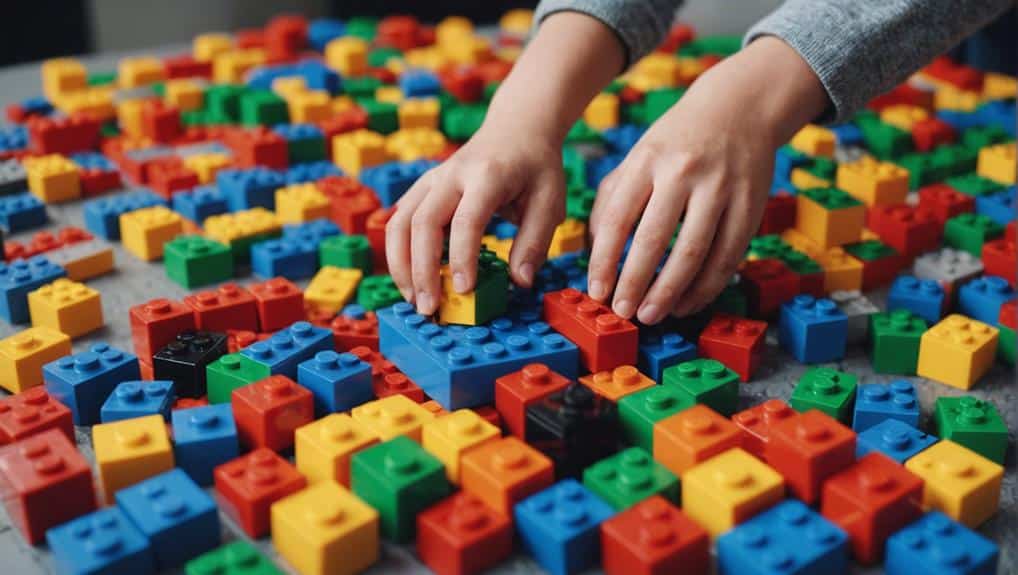
Moving beyond drawing activities, another effective way to enhance hand-eye coordination in children while nurturing their creativity is through building with blocks and Lego. This fun-filled activity provides the perfect platform to develop critical fine motor skills and spatial awareness, all while sparking their imagination.
- Developing fine motor skills: Gripping, stacking, and aligning blocks or Lego pieces aids in refining children’s fine motor skills. It requires a high degree of control and precision, which subsequently improves their hand-eye coordination.
- Promoting creativity: The infinite possibilities of creating structures with blocks and Legos stimulate children’s problem-solving abilities.
- Enhancing spatial awareness: Through building, children learn to understand spatial relationships and construction concepts, contributing to cognitive development.
- Improving attention span: Building intricate structures requires patience, attention to detail, and persistence. These skills help extend students’ attention spans, which benefits their academic pursuits.
Thus, incorporating blocks and Lego into playtime is enjoyable for children and an effective method to foster their hand-eye coordination and fine motor skills.
Frequently Asked Questions
How can I help my child improve their essential hand-eye coordination?
Engage your child in fun, interactive activities challenging their hand movements and visual tracking. These exercises strengthen their hand-eye coordination, improving their overall development and skill mastery.
How to Improve Hand-Eye Coordination in Kids?
Engaging in activities like cursive writing, drawing, outdoor games, puzzles, and sports can improve hand-eye coordination in children. These exercises help develop fine motor skills, enhancing overall physical and cognitive development.
What Is the Game for Hand-Eye Coordination for Kids?
Bean bag toss, racket sports, threading activities, and art exercises are excellent games that promote hand-eye coordination in children, skillfully blending amusement and motor skill development in a child-friendly way.
What Are Three Examples of Toys That Help Develop Hand-Eye Coordination in a Child?
Building blocks or Legos, puzzles, and threading or lacing toys are all excellent choices for enhancing a child’s hand-eye coordination. These toys demand precise movements and accurate shape or color matching.
How Do You Intend to Encourage the Development of This Child’s Eye Hand Coordination?
Why not introduce engaging activities to enhance children’s hand-eye coordination? We can foster these skills by incorporating drawing, threading, and catching games. Moreover, promoting outdoor sports and crafting can further nurture their fine motor abilities.
Conclusion
Through various fun and engaging activities, children naturally develop essential hand-eye coordination. Whether they are popping balloons, playing catch with a tennis ball, or threading beads, each activity helps them improve their reaction time and motor control. These playful exercises are not just for fun—they are crucial to developing the coordination skills needed for everyday tasks and activities.
Children engaging in these activities enhance their focus, precision, and cognitive development. Simple tasks like catching a ball or coloring shapes with different colors may seem minor, but they significantly contribute to a child’s growth. Playing catch, building with blocks, or engaging in creative arts like finger painting helps refine their eye-hand coordination and strengthen their grip.
By integrating these activities into their daily routine, parents and caregivers meaningfully support their child’s overall development. These enjoyable exercises make the journey of improving essential hand-eye coordination both practical and fun. Remember, every bit of coordination drilling adds up, and the commitment to these simple yet impactful activities paves the way for better performance in all aspects of daily life.

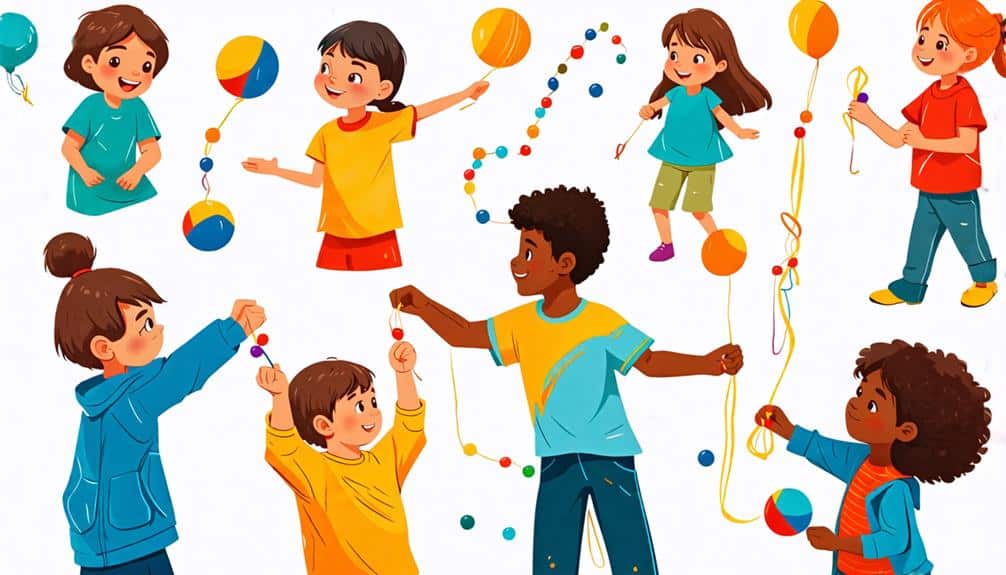
Recent Comments